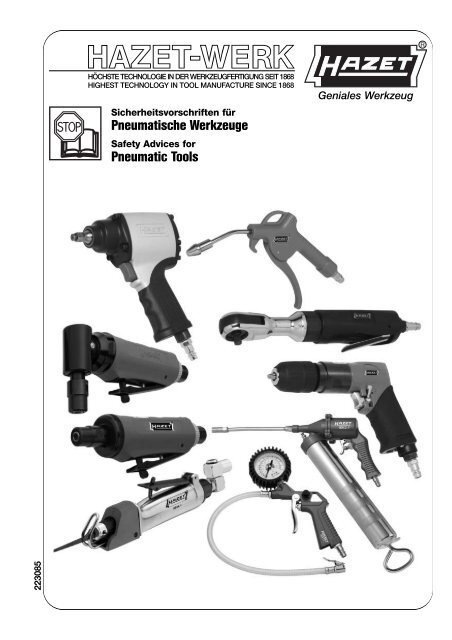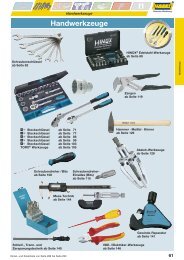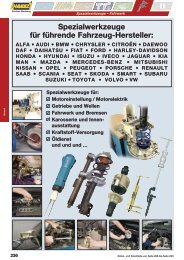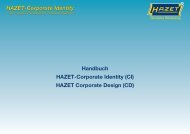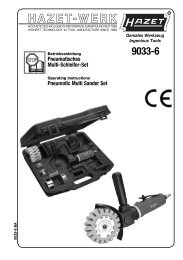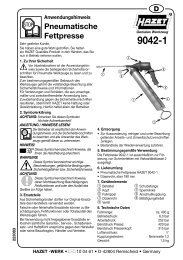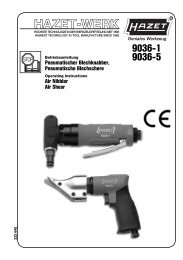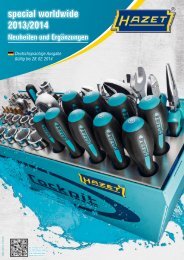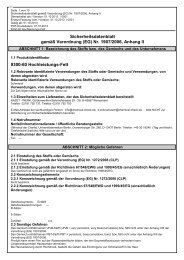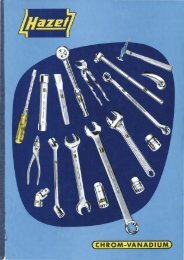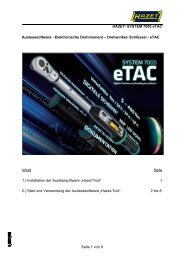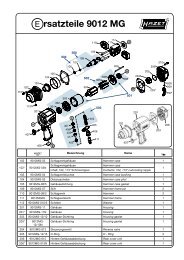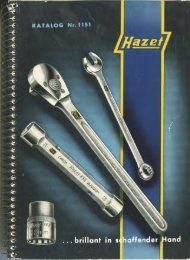Zu Ihrer Information - Hazet
Zu Ihrer Information - Hazet
Zu Ihrer Information - Hazet
Sie wollen auch ein ePaper? Erhöhen Sie die Reichweite Ihrer Titel.
YUMPU macht aus Druck-PDFs automatisch weboptimierte ePaper, die Google liebt.
HAZET-WERK<br />
HÖCHSTE TECHNOLOGIE IN DER WERKZEUGFERTIGUNG SEIT 1868<br />
HIGHEST TECHNOLOGY IN TOOL MANUFACTURE SINCE 1868<br />
Sicherheitsvorschriften für<br />
Pneumatische Werkzeuge<br />
Safety Advices for<br />
Pneumatic Tools<br />
Geniales Werkzeug<br />
223085
D ........................................................................................................ 3 ...18<br />
1 <strong>Zu</strong> <strong>Ihrer</strong> <strong>Information</strong><br />
1. Allgemeine <strong>Information</strong> . . . . . . . . . . . . . . . . . . . . . . . . . . . . . 3<br />
2. Symbolerklärung . . . . . . . . . . . . . . . . . . . . . . . . . . . . . . . . . . 3<br />
3. Haftung und Gewährleistung . . . . . . . . . . . . . . . . . . . . . . . . 3<br />
4. Ersatzteile . . . . . . . . . . . . . . . . . . . . . . . . . . . . . . . . . . . . . . . 4<br />
5. Entsorgung . . . . . . . . . . . . . . . . . . . . . . . . . . . . . . . . . . . . . . 4<br />
6. EG-Konformität . . . . . . . . . . . . . . . . . . . . . . . . . . . . . . . . . . . 4<br />
7. Wartung und Pflege . . . . . . . . . . . . . . . . . . . . . . . . . . . . . . . 5<br />
8. Störungen . . . . . . . . . . . . . . . . . . . . . . . . . . . . . . . . . . . . . . . 5<br />
2 <strong>Zu</strong> <strong>Ihrer</strong> Sicherheit<br />
1. Allgemeines . . . . . . . . . . . . . . . . . . . . . . . . . . . . . . . . . . . . . . 6<br />
2. Verantwortung des Betreibers . . . . . . . . . . . . . . . . . . . . . . . 6<br />
3. Bestimmungsgemäße Verwendung . . . . . . . . . . . . . . . . . . . 6<br />
4. Gefahren die vom Gerät ausgehen . . . . . . . . . . . . . . . . . . . 7 - 8<br />
USA GB ............................................................................................ 19 ...14<br />
1 For Your <strong>Information</strong><br />
1. General <strong>Information</strong> . . . . . . . . . . . . . . . . . . . . . . . . . . . . . . . 9<br />
2. Explanation of Symbols . . . . . . . . . . . . . . . . . . . . . . . . . . . . 9<br />
3. Liability and Warranty . . . . . . . . . . . . . . . . . . . . . . . . . . . . . . 9<br />
4. Spare Parts . . . . . . . . . . . . . . . . . . . . . . . . . . . . . . . . . . . . . . 10<br />
5. Disposal . . . . . . . . . . . . . . . . . . . . . . . . . . . . . . . . . . . . . . . . 10<br />
6. CE Conformity . . . . . . . . . . . . . . . . . . . . . . . . . . . . . . . . . . . 10<br />
7. Mainteance and Cleaning . . . . . . . . . . . . . . . . . . . . . . . . . . . 11<br />
8. Trouble Shooting . . . . . . . . . . . . . . . . . . . . . . . . . . . . . . . . . . 11<br />
2 For Your Safety<br />
1. General Aspects . . . . . . . . . . . . . . . . . . . . . . . . . . . . . . . . . . 12<br />
2. Liability . . . . . . . . . . . . . . . . . . . . . . . . . . . . . . . . . . . . . . . . . 12<br />
3. Appropriate Use . . . . . . . . . . . . . . . . . . . . . . . . . . . . . . . . . . 12<br />
4. Dangers emanating from the tool . . . . . . . . . . . . . . . . . . . . 13 - 14<br />
HAZET-WERK • } 10 04 61 • 42804 Remscheid • Germany • [ +49 (0) 21 91 / 7 92-0<br />
\ +49 (0) 21 91 / 7 92-375 (National) • \ +49 (0) 21 91 / 7 92-400 (International)<br />
^ hazet.com • ] info@hazet.de<br />
2
Sehr geehrter Kunde,<br />
Sie haben gut gewählt, denn vor<br />
Ihnen liegt ein HAZET-Qualitäts-<br />
Produkt. Bitte folgen Sie den<br />
Betriebsanleitungen, den Anwendungshinweisen<br />
und diesen Sicherheitsvorschriften,<br />
damit Sie lange und sicher mit<br />
Ihrem neuen Werkzeug arbeiten können.<br />
1. Allgemeine <strong>Information</strong>en<br />
• Bitte stellen Sie sicher, dass der Benutzer<br />
dieses Werkzeugs die zugehörigen<br />
Betriebsanleitungen, die Anwendungshinweise<br />
sowie diese Sicherheitsvorschriften<br />
vor der ersten Inbetriebnahme<br />
gründlich durchgelesen und verstanden<br />
hat.<br />
• Die Betriebsanleitungen, die Anwendungshinweise<br />
sowie diese Sicherheitsvorschriften<br />
enthalten wichtige Hinweise,<br />
die zum sicheren und störungsfreien<br />
Betrieb Ihres HAZET-Werkzeuges erforderlich<br />
sind.<br />
• <strong>Zu</strong>m bestimmungsgemäßen Gebrauch des<br />
Werkzeuges gehört die vollständige<br />
Beachtung aller Sicherheitshinweise und<br />
<strong>Information</strong>en.<br />
• Bewahren Sie deshalb die zugehörige<br />
Betriebsanleitungen, den Anwendungshinweis<br />
sowie diese Sicherheitsvorschriften<br />
immer bei Ihrem HAZET-Werkzeug auf.<br />
• Die Pneumatik-Werkzeuge wurden für<br />
bestimmte Anwendungen entwickelt.<br />
HAZET weist ausdrücklich darauf hin, dass<br />
diese Werkzeuge nicht verändert und/oder<br />
in einer Weise eingesetzt werden dürfen,<br />
die nicht ihrem vorgesehenen<br />
Verwendungszweck entspricht.<br />
• Für Verletzungen und Schäden, die aus<br />
unsachgemäßer und zweckentfremdeter<br />
Anwendung bzw. <strong>Zu</strong>widerhandlung gegen<br />
die Sicherheitsvorschriften resultieren,<br />
übernimmt HAZET keine Haftung oder<br />
Gewährleistung.<br />
• Darüber hinaus sind die für den Einsatzbereich<br />
des Werkzeugs geltenden<br />
Unfallverhütungsvorschriften und allgemeinen<br />
Sicherheitsbestimmungen einzuhalten.<br />
<strong>Zu</strong> <strong>Ihrer</strong> <strong>Information</strong><br />
D<br />
2. Symbolerklärung<br />
ACHTUNG: Schenken Sie diesen Symbolen<br />
höchste Aufmerksamkeit!<br />
ANLEITUNGEN/HINWEISE LESEN!<br />
Der Betreiber ist verpflichtet alle<br />
Anwendungshinweise, Betriebsanleitungen<br />
und Sicherheitsvorschriften<br />
zu lesen und zu beachten und alle<br />
Anwender des Werkzeugs gemäß<br />
dieser zu unterweisen.<br />
HINWEIS!<br />
Dieses Symbol kennzeichnet<br />
Hinweise, die Ihnen die Handhabung<br />
erleichtern.<br />
WARNUNG!<br />
Dieses Symbol kennzeichnet wichtige<br />
Beschreibungen, gefährliche Bedingungen,<br />
Sicherheitsgefahren bzw.<br />
Sicherheitshinweise.<br />
ACHTUNG!<br />
Dieses Symbol kennzeichnet Hinweise,<br />
deren Nichtbeachtung Beschädigungen,<br />
Fehlfunktionen und/oder<br />
den Ausfall des Gerätes zur Folge<br />
haben.<br />
3. Haftung und<br />
Gewährleistung<br />
• Jede über die bestimmungsgemäße<br />
Verwendung hinausgehende und/oder<br />
andersartige Verwendung des Gerätes ist<br />
untersagt und gilt als nicht bestimmungsgemäß.<br />
• Ansprüche jeglicher Art gegen den Hersteller<br />
und/oder seine Bevollmächtigten<br />
aus Schäden durch nicht bestimmungsgemäße<br />
Verwendung des Gerätes sind<br />
ausgeschlossen.<br />
• Für alle Schäden bei nicht bestimmungsgemäßer<br />
Verwendung haftet allein der<br />
Betreiber.<br />
• Die bestimmungsgemäße Verwendung der<br />
Pneumatik-Werkzeuge ist in den zugehörigen<br />
Betriebsanleitungen und Anwendungshinweisen<br />
beschrieben.<br />
Angeschlossenes Druckluft-Werkzeug nicht unbeaufsichtigt lassen.<br />
Immer persönliche Schutzausrüstung tragen!<br />
3
D<br />
4. Ersatzteile<br />
• Nur Original-Ersatzteile des Herstellers<br />
verwenden.<br />
• Falsche oder fehlerhafte Ersatzteile können<br />
zu Beschädigungen, Fehlfunktionen oder<br />
Totalausfall des Werkzeuges führen.<br />
• Bei Verwendung nicht freigegebener Ersatzteile<br />
erlöschen sämtliche Garantie-,<br />
Service-, Schadenersatz- und<br />
Haftpflichtansprüche gegen den Hersteller<br />
oder seine Beauftragten, Händler und<br />
Vertreter.<br />
<strong>Zu</strong> <strong>Ihrer</strong> <strong>Information</strong><br />
5. Entsorgung<br />
• <strong>Zu</strong>r Aussonderung, reinigen und unter<br />
Beachtung geltender Arbeits- und<br />
Umweltschutzvorschriften zerlegen. Bestandteile<br />
der Wiederverwertung zuführen.<br />
Die Verringerung von Umweltbelastungen<br />
und die Bewahrung der Umwelt, stehen im<br />
Mittelpunkt unserer Aktivitäten!<br />
Bei HAZET wird Umweltschutz groß<br />
geschrieben.<br />
6. EG-Konformität<br />
• Die <strong>Information</strong> über die Konformität zu EG<br />
Richtlinien finden Sie in der beigefügten<br />
Konformitäts-Erklärung.<br />
Angeschlossenes Druckluft-Werkzeug nicht unbeaufsichtigt lassen.<br />
Immer persönliche Schutzausrüstung tragen!<br />
4
Die Benutzung, Inspektion und<br />
Wartung von Pneumatik-Werkzeugen<br />
muss immer entsprechend den lokalen<br />
staatlichen Landes- oder Bundesbestimmungen<br />
erfolgen.<br />
7. Wartung<br />
• Vor der Durchführung von Wartungsarbeiten<br />
ist das Gerät immer von der<br />
Druckluft-<strong>Zu</strong>fuhr zu lösen.<br />
• <strong>Zu</strong>r Reinigung des Werkzeuges oder seiner<br />
Einzelteile wird der Gebrauch von<br />
Waschbenzin empfohlen.<br />
• Reinigen Sie nie mit Lösungsmitteln oder<br />
Säuren, Estern (organischen Verbindungen<br />
aus Säuren und Alkohol), Aceton (Keton),<br />
Chlorkohlenwasserstoffen oder nitrokarbonathaltigen<br />
Ölen. Verwenden Sie keine<br />
Chemikalien mit niedrigem Flammpunkt.<br />
• Beschädigte oder abgenutzte Bauteile wie<br />
O-Ringe, Lager, Drehklingen usw. sind zu<br />
ersetzen.<br />
• Es sind ausschließlich vom Hersteller<br />
empfohlene Ersatzteile zu verwenden,<br />
andernfalls erlischt die Gewährleistung.<br />
• Achten Sie bei der Entsorgung von Einzelteilen,<br />
Schmier- und Reinigungsmitteln<br />
darauf, dass die entsprechenden Richtlinien<br />
zum Umweltschutz eingehaltenwerden.<br />
• Kompressortank entwässern und<br />
Kondenswasser aus den Luftleitungen entfernen.<br />
Lesen Sie die Betriebsanleitung für<br />
den Kompressor ebenfalls gründlich durch.<br />
Ölen:<br />
• Pneumatik-Werkzeuge müssen während<br />
ihrer gesamten Lebensdauer geölt werden.<br />
Der Motor und die Kugellager benötigen<br />
Druckluft, um das Werkzeug anzutreiben.<br />
Da die Feuchtigkeit in der Druckluft den<br />
Motor rosten lässt, muss der Motor täglich<br />
geölt werden. Hierfür ist die Verwendung<br />
eines integrierten Ölers zu empfehlen.<br />
• HAZET 9070-1 Öler zur Montage am<br />
Pneumatik-Werkzeug.<br />
WICHTIG:<br />
Die Verwendung von Luftfiltern<br />
und eines Druckluft-Leitungsölers<br />
ist zu empfehlen.<br />
<strong>Zu</strong> <strong>Ihrer</strong> <strong>Information</strong><br />
D<br />
ACHTUNG!<br />
Vor dem Ölen, Anschließen oder<br />
Abkoppeln des Werkzeuges, die<br />
Druckluft-<strong>Zu</strong>fuhr unterbrechen.<br />
Ölen des pneumatischen Motors von<br />
Hand:<br />
• Werkzeug von der Luftzufuhr abkoppeln<br />
und mit dem Lufteinlass nach oben halten.<br />
Ein bis zwei Tropfen Spezial-Druckluftöl in<br />
den Lufteinlass geben.<br />
• Werkzeug an die Druckluft-<strong>Zu</strong>fuhr<br />
anschließen, Luftauslass am Werkzeug mit<br />
einem Handtuch abdecken und einige<br />
Sekunden laufen lassen.<br />
• Für das Ölen des Werkzeugs nie brennbare<br />
oder leicht verdampfende Flüssigkeiten wie<br />
Kerosin, Diesel oder Benzin verwenden.<br />
ACHTUNG!<br />
Überschüssiges Öl im Motor wird<br />
sofort durch den Luftauslass ausgestoßen.<br />
WARNUNG!<br />
Auslassöffnung nie auf Menschen<br />
oder Objekte richten.<br />
8. Störungen<br />
<strong>Zu</strong>r Störungsbeseitigung bitte prüfen:<br />
• Kompressionsanlage und Druckluft-<br />
<strong>Zu</strong>leitung, Luftverbrauch l/min und<br />
Schlauchquerschnitt entsprechen den<br />
technischen Anforderungen des Gerätes?<br />
• Betriebsluft untersuchen, enthält Staub und<br />
Rostanteile oder Kondensat?<br />
• Luftmotor ist überölt?<br />
• <strong>Zu</strong>r Inanspruchnahme des Kundendienstes<br />
setzen Sie sich bitte mit Ihrem Händler oder<br />
dem HAZET-Service Center in Verbindung.<br />
Angeschlossenes Druckluft-Werkzeug nicht unbeaufsichtigt lassen.<br />
Immer persönliche Schutzausrüstung tragen!<br />
5
6<br />
D<br />
Dieser Abschnitt gibt einen Überblick<br />
über alle wichtigen Sicherheitsaspekte<br />
für einen optimalen Schutz des<br />
Personals sowie den sicheren und<br />
störungsfreien Betrieb des Gerätes.<br />
<strong>Zu</strong>sätzlich beinhalten die einzelnen Kapitel<br />
konkrete, mit Symbolen gekennzeichnete<br />
Sicherheitshinweise zur Abwendung unmittelbarer<br />
Gefahren. Darüber hinaus sind am Gerät<br />
befindliche Piktogramme, Schilder und<br />
Beschriftungen zu beachten und in ständig<br />
lesbarem <strong>Zu</strong>stand zu halten.<br />
1. Allgemeines<br />
• Das Gerät ist zum Zeitpunkt seiner Entwicklung<br />
und Fertigung nach geltenden,<br />
anerkannten Regeln der Technik gebaut<br />
und gilt als betriebssicher. Es können vom<br />
Gerät jedoch Gefahren ausgehen, wenn es<br />
von nicht fachgerecht ausgebildetem Personal,<br />
unsachgemäß oder nicht bestimmungsgemäß,<br />
verwendet wird. Jede Person,<br />
die mit Arbeiten am oder mit dem<br />
Gerät beauftragt ist, muss daher die<br />
Betriebsanleitungen, die Anwendungshinweise<br />
und die Sicherheitsvorschriften<br />
vor Beginn der Arbeiten gelesen und verstanden<br />
haben.<br />
• Veränderungen jeglicher Art sowie An- oder<br />
Umbauten am Gerät sind untersagt.<br />
• Alle Sicherheits-, Warn- und Bedienungshinweise<br />
am Gerät sind stets in gut lesbarem<br />
<strong>Zu</strong>stand zu halten. Beschädigte Schilder<br />
oder Aufkleber müssen sofort erneuert<br />
werden.<br />
• Angegebene Einstellwerte oder -bereiche<br />
sind unbedingt einzuhalten.<br />
2. Verantwortung<br />
des Betreibers<br />
• Die Betriebsanleitungen, die Anwendungshinweise<br />
und die Sicherheitsvorschriften<br />
sind stets in unmittelbarer Nähe des Geräts<br />
aufzubewahren.<br />
• Gerät nur in technisch einwandfreiem und<br />
betriebssicherem <strong>Zu</strong>stand betreiben.<br />
• Sicherheitseinrichtungen immer frei erreichbar<br />
vorhalten und regelmäßig prüfen.<br />
• Neben den Arbeitssicherheits-Hinweisen in<br />
den zugehörigen Betriebsanleitungen bzw.<br />
den Anwendungshinweisen sind diese<br />
Sicherheitsvorschriften und die für den<br />
<strong>Zu</strong> <strong>Ihrer</strong> Sicherheit<br />
Einsatzbereich des Gerätes allgemein<br />
gültigen Sicherheits-, Unfallverhütungsund<br />
Umweltschutzvorschriften zu beachten<br />
und einzuhalten.<br />
3. Bestimmungsgemäße<br />
Verwendung<br />
Die Betriebssicherheit ist nur bei bestimmungsgemäßer<br />
Verwendung entsprechend den<br />
Angaben in den Betriebsanleitungen, den<br />
Anwendungshinweisen und unter Berücksichtigung<br />
der Sicherheitsvorschriften gewährleistet.<br />
Die Benutzung und Wartung muss immer entsprechend<br />
den lokalen staatlichen Landesoder<br />
Bundesbestimmungen erfolgen.<br />
• Die bestimmungsgemäße Verwendung des<br />
jeweiligen Pneumatik-Werkzeuges ist in<br />
den zugehörigen Betriebsanleitungen bzw.<br />
den Anwendungshinweisen definiert.<br />
• Der unsachgemäße Gebrauch des HAZET-<br />
Pneumatik-Werkzeuges oder der Gebrauch<br />
nicht entsprechend den Sicherheitsvorschriften<br />
kann zu schweren Verletzungen<br />
oder zum Tode führen.<br />
• Jede über die bestimmungsgemäße<br />
Verwendung hinausgehende und/oder<br />
andersartige Verwendung des Gerätes ist<br />
untersagt und gilt als nicht bestimmungsgemäß.<br />
• Ansprüche jeglicher Art gegen den<br />
Hersteller und/oder seine Bevollmächtigten<br />
aus Schäden durch nicht bestimmungsgemäße<br />
Verwendung des Gerätes sind<br />
ausgeschlossen.<br />
• Für alle Schäden bei nicht bestimmungsgemäßer<br />
Verwendung haftet allein der<br />
Betreiber.<br />
Angeschlossenes Druckluft-Werkzeug nicht unbeaufsichtigt lassen.<br />
Immer persönliche Schutzausrüstung tragen!
4. Gefahren die vom<br />
Gerät ausgehen<br />
Vor jeder Benutzung ist das HAZET-<br />
Werkzeug auf seine volle Funktionsfähigkeit<br />
zu prüfen. Ist die Funktionsfähigkeit<br />
nach dem Ergebnis dieser Prüfung<br />
nicht gewährleistet oder werden Schäden festgestellt,<br />
darf das Werkzeug nicht verwendet<br />
werden. Ist die volle Funktionsfähigkeit nicht<br />
gegeben und das Werkzeug wird dennoch verwendet,<br />
besteht die Gefahr von erheblichen<br />
Körper-, Gesundheits- und Sachschäden.<br />
• Werkzeuge, bei denen der Ein-/Aus-<br />
Schalter defekt ist, dürfen nicht verwendet<br />
werden. Werkzeuge, die nicht mehr mit dem<br />
Ein-/Aus-Schalter ein- bzw. ausgeschaltet<br />
werden können, sind gefährlich und müssen<br />
repariert werden.<br />
• Alle Service- oder Reparaturarbeiten immer<br />
durch Fachpersonal ausführen lassen. Um<br />
die Betriebssicherheit auf Dauer zu gewährleisten,<br />
dürfen nur Originalersatzteile verwendet<br />
werden.<br />
• Schutzvorrichtungen und/oder Gehäuseteile<br />
dürfen nicht entfernt werden.<br />
• Betätigen Sie das Werkzeug nie wenn eine<br />
Schutzabdeckung fehlt oder wenn nicht alle<br />
Sicherheitseinrichtungen vorhanden und in<br />
einwandfreiem <strong>Zu</strong>stand sind.<br />
• Aus Sicherheitsgründen sind Veränderungen<br />
an HAZET-Werkzeugen untersagt.<br />
Die Vornahme von Veränderungen am Gerät<br />
führt zum sofortigen Haftungsausschluß.<br />
• Arbeitshandschuhe tragen.<br />
Während des Last-<br />
Betriebes werden<br />
Vibrationen vom Gerät auf<br />
den Betreiber übertragen.<br />
Unbedingt Arbeitshandschuhe<br />
tragen.<br />
• Schutzbrille tragen. Werkzeuge<br />
mit pneumatischem<br />
Antrieb können Späne,<br />
Staub und anderen Abrieb<br />
mit hoher Geschwindigkeit<br />
aufwirbeln, was zu schweren Augenverletzungen<br />
führen kann. Druckluft ist gefährlich.<br />
Der Luftstrom kann empfindliche<br />
Körperteile wie Augen, Ohren etc. schädigen.<br />
Vom Luftstrom aufgewirbelte<br />
Gegenstände und Staub können zu<br />
Verletzungen führen.<br />
<strong>Zu</strong> <strong>Ihrer</strong> Sicherheit<br />
D<br />
• Gehörschutz tragen.<br />
Lange Belastung durch die<br />
Arbeitsgeräusche eines<br />
Druckluft-Werkzeuges kann<br />
zum<br />
dauerhaften<br />
Gehörverlust führen.<br />
• Gesichtsmaske oder<br />
Atemschutz tragen. Einige<br />
Materialien wie Klebstoffe<br />
und Teer enthalten Chemikalien,<br />
deren Dämpfe, über<br />
einen längeren Zeitraum eingeatmet,<br />
schwere Schädigungen verursachen<br />
können.<br />
• Enganliegende Arbeitsschutzkleidung<br />
tragen.<br />
Werkzeuge mit drehenden<br />
Teilen können sich in<br />
Haaren, Kleidung, Schmuck<br />
oder anderen losen Gegenständen<br />
verfangen, was zu<br />
schweren Verletzungen führen kann. Tragen<br />
Sie niemals zu weite und/oder mit Bändern<br />
oder Schlaufen etc. versehene Kleidung, die<br />
sich in den drehenden Werkzeugteilen verfangen<br />
kann. Legen Sie bei der Arbeit sämtlichen<br />
Schmuck, Uhren, Identifikationsmarken,<br />
Armbänder, Halsketten etc. ab, die<br />
sich am Werkzeug verfangen könnten.<br />
Fassen Sie niemals Werkzeugteile an, die in<br />
Bewegung sind. Lange Haare sollen<br />
zusammengebunden oder bedeckt werden.<br />
• Pneumatik-Werkzeuge gehören nicht in<br />
Kinderhände. Unbeaufsichtigte oder an die<br />
Druckluft-<strong>Zu</strong>fuhr angeschlossene Werkzeuge<br />
können von nicht autorisierten<br />
Personen benutzt werden und zu deren<br />
oder zur Verletzung dritter Personen führen.<br />
• Gerät nicht in explosionsgefährdeten<br />
Räumen verwenden. Pneumatik-<br />
Werkzeuge können Funkenschlag verursachen,<br />
der zur Entzündung brennbarer<br />
Materialien führen kann. Werkzeuge nie in<br />
der Nähe von brennbaren Substanzen wie<br />
Benzin, Naphtha oder Reinigungsmitteln<br />
etc. betätigen. Nur in sauberen, gut gelüfteten<br />
Bereichen arbeiten, in denen sich keine<br />
brennbaren Materialien befinden. Niemals<br />
Sauerstoff, Kohlendioxid oder andere in<br />
Flaschen abgefüllte Gase zum Antrieb von<br />
Pneumatik-Werkzeugen verwenden.<br />
Angeschlossenes Druckluft-Werkzeug nicht unbeaufsichtigt lassen.<br />
Immer persönliche Schutzausrüstung tragen!<br />
7
D<br />
• Pneumatik-Werkzeuge nie gegen<br />
Menschen, Tiere oder sich selbst richten.<br />
Bei Betrieb des Werkzeuges Kinder und<br />
andere Personen aus dem Arbeitsbereich<br />
fernhalten.<br />
• Gerät nie unbelastet laufen lassen.<br />
Werkzeuge wie z.B. Meißel etc. können<br />
abbrechen und weggeschleudert werden<br />
und den Bediener oder Personen treffen,<br />
die sich im Arbeitsbereich aufhalten.<br />
• Pneumatik-Werkzeuge dürfen nicht in<br />
Kontakt mit Stromquellen kommen.<br />
• Auf Betriebsdruck achten, max.<br />
Luftdruck in den jeweiligen Betriebsanleitungen<br />
oder Anwendungshinweisen<br />
nachlesen. Das Überschreiten des zulässigen<br />
Maximaldrucks von Werkzeugen und<br />
<strong>Zu</strong>behörteilen kann Explosionen verursachen<br />
und zu schweren Verletzungen führen.<br />
Der Maximaldruck der Druckluft muss<br />
gleich oder unterhalb der zulässigen Druckbelastungsangaben<br />
des Pneumatik-Werkzeugs<br />
liegen.<br />
• Schlauchverbindung auf festen Sitz prüfen.<br />
Keine schadhaften, abgenutzten<br />
oder minderwertigen Druckschläuche<br />
oder Verbindungsstücke verwenden.<br />
Umherschlagende Druckschläuche können<br />
zu schweren Verletzungen führen.<br />
• Pneumatik-Werkzeuge nur im drucklosen<br />
<strong>Zu</strong>stand abklemmen.<br />
Umherschlagende Druckschläuche können<br />
zu schweren Verletzungen führen.<br />
• Nur trockene, saubere Luft verwenden.<br />
Verwenden Sie niemals Sauerstoff, Kohlendioxid<br />
oder andere in Flaschen abgefüllte<br />
Gase zum Antrieb von Pneumatik-<br />
Werkzeugen.<br />
• Verwenden Sie nur vom Hersteller empfohlene<br />
Ersatzteile, Befestigungen und<br />
<strong>Zu</strong>behör.<br />
• Das Werkzeug niemals am Druckluft-<br />
Schlauch tragen.<br />
• Das angeschlossene Werkzeug niemals<br />
mit dem Finger am Betätigungshebel tragen.<br />
• Unbeabsichtigte Betätigung vermeiden.<br />
• Griffe immer trocken, sauber, öl- und<br />
fettfrei halten.<br />
• Achten Sie auf einen sauberen, gut gelüfteten<br />
und stets gut beleuchteten Arbeitsbereich.<br />
<strong>Zu</strong> <strong>Ihrer</strong> Sicherheit<br />
• Das Werkzeug niemals unter Alkoholoder<br />
Drogeneinfluss benutzen.<br />
• Kennzeichnung des Gerätes muss immer<br />
gut lesbar sein.<br />
• Pneumatik-Werkzeuge dürfen nur von<br />
unterwiesenen Personen bedient und<br />
gewartet werden.<br />
• Reparaturen nur von autorisierten<br />
Personen durchführen lassen.<br />
• An Pneumatik-Werkzeugen dürfen keine<br />
Manipulationen, Notreparaturen oder<br />
Zweckentfremdungen vorgenommen werden.<br />
• Während der Arbeit mit Pneumatik-<br />
Werkzeugen nicht in den Arbeitsbereich<br />
greifen.<br />
• Treten Undichtigkeiten am Gerät oder<br />
andere Betriebsstörungen auf, ist das<br />
Gerät sofort von der Druckluft-Quelle zu<br />
trennen und die Fehlerursache zu beheben.<br />
• Verwenden Sie Schnellkupplungen nie<br />
direkt am Gerät. Die Schnellkupplung muß<br />
durch einen mindestens 20 cm langen<br />
Luftschlauch vom Gerät getrennt sein.<br />
• <strong>Zu</strong> betätigende Werkzeuge wie z.B.<br />
Meißel, Nadeln. Steckschlüssel-Einsätze<br />
usw. nur bei abgekuppeltem Luftschlauch<br />
auswechseln.<br />
• <strong>Zu</strong>m Ölen oder zum Austausch der zu betätigenden<br />
Werkzeuge wie z.B. Meißel, Nadeln.<br />
Steckschlüssel-Einsätze usw. das<br />
Pneumatik-Werkzeug immer von der<br />
Druckluft-<strong>Zu</strong>fuhr trennen.<br />
• Achten Sie immer auf den einwandfreien<br />
<strong>Zu</strong>stand der zu betätigenden Werkzeuge.<br />
• Verwenden Sie nur für das jeweilige Gerät<br />
vorgesehene Werkzeuge, wie z.B. Meißel für<br />
Meißelhämmer, Schleifscheiben und Bänder<br />
für pneumatische Schleifgeräte, etc.<br />
• Auf Reaktionsmoment achten. Auf die<br />
Bildung von Reaktionsmomenten und den<br />
möglichen Bruch des Werkzeuges achten. An<br />
engen Stellen können Reaktionsmomente zu<br />
Verletzungen führen. Gegen unerwartete<br />
Reaktionsmomente müssen Gegenmaßnahmen<br />
getroffen werden.<br />
• Dauerhafte Vibration kann zu Gesundheitsschäden<br />
führen.<br />
• Auf sicheren Stand achten.<br />
Angeschlossenes Druckluft-Werkzeug nicht unbeaufsichtigt lassen.<br />
Immer persönliche Schutzausrüstung tragen!<br />
8
USA<br />
Dear Customer,<br />
You have made a good choice.<br />
This HAZET tool in front of you is a<br />
high-quality product. Please follow<br />
the operating instructions, application<br />
notes as well as these safety<br />
regulations in order to be able to work safely<br />
during a long period of time with your new tool.<br />
1. General <strong>Information</strong><br />
• Please make sure that the user of this tool<br />
carefully reads the relevant operating instructions,<br />
application notes as well as these<br />
safety regulations and fully understands all<br />
information given herein before it is used.<br />
• The operating instructions, the application<br />
notes and these safety regulations contain<br />
important advice that is necessary for a safe<br />
and trouble-free operation of your HAZET<br />
tool.<br />
• For effective use of the tool as intended, it is<br />
essential that all safety and other information<br />
in the relevant operating instructions, the<br />
application notes as well as these safety<br />
regulations is adhered to.<br />
• For this reason, always keep the relevant<br />
operating instructions, the application<br />
notes as well as these safety regulations<br />
together with your HAZET tool.<br />
• This tool has been designed exclusively for<br />
specific applications. HAZET emphasizes that<br />
any modification to the tool and/or use on an<br />
application not detailed to its intended application<br />
are strictly forbidden.<br />
• HAZET will not be liable for any injuries to persons<br />
or damage to property originating from<br />
improper application, misuse of the tool or a<br />
disregard of the safety instructions.<br />
• Furthermore, the general safety regulations<br />
and regulations for the prevention of accidents<br />
valid for the application area of this tool<br />
must be observed and respected.<br />
For Your <strong>Information</strong><br />
GB<br />
2. Explanation of Symbols<br />
ATTENTION : Please pay attention to these<br />
symbols!<br />
READ THE OPERATING INSTRUCTIONS!<br />
The operator is obliged to observe<br />
the operating instructions and must<br />
ensure that all users of this tool use<br />
it according to the information given<br />
in this manual.<br />
NOTICE!<br />
This symbol marks advice which is<br />
helpful when using the tool.<br />
CAUTION!<br />
This symbol marks important specifications,<br />
dangerous conditions, safety<br />
risks and safety advice.<br />
ATTENTION!<br />
This symbol marks advice which if<br />
disregarded results in damage, malfunction<br />
and/or functional failure of<br />
the tool.<br />
3. Liability and Warranty<br />
• Any deviation from the intended use and/<br />
or any misapplication of the tool is not<br />
allowed and will be considered as improper<br />
use.<br />
• Any claims against the manufacturer and/or<br />
its authorized agents because of damage<br />
caused by improper use of the tool are void.<br />
• Any personal injury or material losses<br />
caused by improper use of the tool are the<br />
sole responsibility of the operator and user.<br />
• As to the appropriate use of pneumtic<br />
tools, please refer to the relevant operating<br />
instructions and application notes.<br />
Don’t leave connected pneumatic tools unattended.<br />
Always wear personal protective clothing and safety equipment!<br />
9
USA<br />
For Your <strong>Information</strong><br />
4. Spare Parts<br />
• Only use the manufacturer’s original spare<br />
parts.<br />
• Unsuitable or defective spare parts may<br />
cause damage, malfunction or total failure of<br />
the tool.<br />
• The use of non-approved spare parts will<br />
void all warranty, service and liability claims<br />
as well as all claims for compensation<br />
against the manufacturer or its agents, distributors<br />
and sales representatives.<br />
GB<br />
5. Disposal<br />
• For disposal, clean tool and disassemble it<br />
according to the regulations for work safety<br />
and environmental protection. Components<br />
can be recycled.<br />
• Metal components can be scrapped.<br />
The reduction of the pollution as well as the<br />
protection of the environment are the central<br />
points of our activities.<br />
HAZET - environmental protection is of fundamental<br />
importance for us.<br />
6. CE Conformity<br />
• You will find the relevant information as to<br />
conformity to CE directives in the enclosed<br />
CE Declaration of Conformity.<br />
Don’t leave connected pneumatic tools unattended.<br />
Always wear personal protective clothing and safety equipment!<br />
10
USA<br />
Pneumatic tools have to be used, inspected<br />
and maintained always in<br />
compliance with the respective local,<br />
state, national or federal regulations.<br />
7. Maintenance and Cleaning<br />
• Before executing any maintenance work,<br />
disconnect the appliance from the air<br />
supply.<br />
• To clean the tools or its components, we<br />
recommend using cleaning solvent.<br />
• Do not use solvents or acids, esters (organic<br />
compounds of acids and alcohol), acetone<br />
(ketone), chlorinated hydrocarbons or nitrocarbonic<br />
oils to clean the tool. Do not use<br />
chemicals with a low flashing point.<br />
• All damaged or worn parts, such as<br />
O-rings, bearings and blades must be replaced.<br />
All moving parts must be oiled.<br />
• Only use spare parts recommended by the<br />
manufacturer, otherwise the warranty will be<br />
void.<br />
• When disposing of components, lubricants,<br />
etc. please take care that the valid regulations<br />
for environmental protection are<br />
observed.<br />
• Drain compressor tank and remove condensation<br />
water from the air hoses. Read thouroughly<br />
the operating instructions of the<br />
compressor tank, too.<br />
Oiling:<br />
• Pneumatic tools have to be oiled throughout<br />
their whole service life. The motor and the<br />
(ball) bearings need compressed air to<br />
power the tool. As the moisture in the compressed<br />
air leads to rust of the motor, daily<br />
oiling of the motor is necessary. For this, the<br />
use of an integrated oiler is recommended.<br />
• HAZET 9070-1 Oiler can be fixed directly to<br />
the pneumatic tool.<br />
For Your <strong>Information</strong><br />
GB<br />
IMPORTANT:<br />
The use of an air filter and an air<br />
hose oiler is recommended.<br />
ATTENTION!<br />
Before oiling, plugging in/out the<br />
tool, disconnect the tool from the<br />
compressed air supply.<br />
Oiling the pneumatic motor manually:<br />
• Disconnect tool from the air supply and hold<br />
with the air inlet showing upwards. Push<br />
button and put 1 or 2 drops of special<br />
pneumatic oil into the air inlet.<br />
• Connect the tool to the air supply; cover the<br />
air exit of the tool with a towel and<br />
operate a few seconds.<br />
• Never use combustible or easily evaporable<br />
liquids, e.g. kerosene, petrol, diesel, etc. to<br />
lubricate the tool.<br />
ATTENTION!<br />
Excess oil in the motor will be<br />
exhausted immediately through the<br />
air exhaust.<br />
CAUTION!<br />
Never point the air exhaust at any<br />
person or at any object. The air<br />
exhaust is at the rear side of the<br />
handle.<br />
8. Trouble Shooting<br />
In case of malfunctions, please check<br />
• The compressor installation and air hoses<br />
(check whether the air consumption l/min<br />
and the hose diameter correspond to the<br />
technical specifications of the appliance);<br />
• The compressed air in regard to the<br />
occurence of dust, condensate and rust<br />
particles;<br />
• Whether the air motor is oiled too much.<br />
• For after sales service please contact your<br />
distributor/retailer.<br />
Don’t leave connected pneumatic tools unattended<br />
Always wear personal protective clothing and safety equipment!<br />
11
USA<br />
This paragraph gives an overview of<br />
important security advice to help to<br />
ensure the optimal protection of the personnel<br />
as well as the safe and troublefree<br />
operation of the tool.<br />
Additionally, the different chapters contain security<br />
advice that is marked with symbols in order<br />
to avert immediate danger. Furthermore, all<br />
stickers and labels on the tool must be observed<br />
and must be kept legible.<br />
For Your Safety<br />
3. Appropriate Use<br />
GB<br />
Operational reliability can only be ensured,<br />
if the tool is used as intended and<br />
in compliance with the indications given in the<br />
operating instructions, the application notes<br />
and safety regulations.<br />
Always ensure tools are used, inspected and<br />
maintained in compliance with the respective<br />
local, state, national or federal regulations.<br />
1. General Aspects<br />
• This tool was developed and manufactured<br />
according to the technical norms<br />
and standards valid at the time and is<br />
considered to be operationally reliable.<br />
Nevertheless, the tool can present a danger<br />
when it is not used as intended or in an inappropriate<br />
way by non-qualified personnel.<br />
Please make sure that any person using this<br />
tool or carrying out maintenance work<br />
carefully reads the operating instructions,<br />
the application notes and the safety regulations<br />
and fully understands all information<br />
given before using the tool.<br />
• Any modification of the tool is strictly<br />
forbidden.<br />
• All security advices, warning and operation<br />
notices on the tool have to be kept legible.<br />
Replace all damaged labels or stickers.<br />
• All indications concerning setting values and<br />
setting ranges must be observed.<br />
2. Liability<br />
• The intended use and application of the<br />
relevant pneumatic tool is defined in the<br />
relevant operating instructions or in the<br />
relevant application note.<br />
• The improper use of the HAZET pneumatic<br />
tool or any use not according to the safety<br />
regulations may cause severe injury or<br />
death.<br />
• Any deviation from the intended use and/<br />
or any misapplication of the tool is not<br />
allowed and will be considered as improper<br />
use.<br />
• Any claims against the manufacturer and/or<br />
its authorized agents because of damage<br />
caused by improper use of the tool will be<br />
void.<br />
• Any personal injury or material losses<br />
caused by improper use are the sole<br />
responsibility of the operator and user.<br />
• Keep the operating instructions, the application<br />
notes and the safety regulations<br />
together with the tool at all times.<br />
• The tool must only be used if it is in good<br />
working order.<br />
• All safety equipment, e.g. fire extinguisher<br />
etc., must always be within reach and<br />
should be checked regularly.<br />
• In addition to the safety advice given in the<br />
operating instructions or in the application<br />
notes, these safety regulations and the<br />
general safety regulations, the regulations<br />
for the prevention of accidents and the<br />
regulations for environmental protection<br />
being valid for the application area of this<br />
tool have to be observed and respected.<br />
12<br />
Don’t leave connected pneumatic tools unattended.<br />
Always wear personal protective clothing and safety equipment!
USA<br />
4. Dangers emanating<br />
from the tool<br />
Before each use, check the HAZET Air<br />
Tool for full functional efficiency.<br />
Do not use the air tool if its functional<br />
efficiency cannot be ensured or if damage is<br />
detected. If the tool is used, when it is not in<br />
full working order, you risk severe injuries to<br />
persons and damage to property. Defective<br />
tools may cause severe injury.<br />
• Do not use tools whose on/off-switch is<br />
defective. Tools that cannot be switched on<br />
or off with their on/off switch are dangerous<br />
and have to be repaired.<br />
• Any service or repair work must be carried<br />
out by qualified personnel only. In order to<br />
guarantee long term operational safety, only<br />
original spare parts of the manufacturer must<br />
be used.<br />
• Do not remove any safety devices and/or<br />
housing parts.<br />
• Do not operate the tool, if safety covers or<br />
safety devices are missing or defective.<br />
• For safety reasons any modification of<br />
HAZET tools is strictly forbidden. Any modification<br />
of the tool will result in immediate<br />
exlcusion from warranty and liability.<br />
• Wear work gloves. During load operation<br />
vibrations are transfered from the appliance<br />
to the operator. Therefore, it is essential to<br />
wear work gloves.<br />
• Wear eye protection. Pneumatic tools can<br />
raise chips, dust and other abraded particles<br />
at high speed what may<br />
result in severe eye injuries.<br />
Compressed air is dangerous.<br />
The air flow may cause<br />
harm to sensitive parts of<br />
the body like eyes, ears, etc.<br />
Dust and objects being<br />
raised by the air flow may<br />
cause injuries.<br />
For Your Safety<br />
GB<br />
• Use ear protection. Long<br />
exhibition to the working<br />
noise of pneumatic tools<br />
may result in a permanent<br />
hearing loss.<br />
• Wear face or dust mask.<br />
Breathing in the steam of<br />
some materials like adhesives<br />
and tar that contain<br />
dangerous chemicals can<br />
cause serious harms to the<br />
lungs and respiratory tracts.<br />
• Wear proper-fitting protective clothing.<br />
Tools with moving parts can get caught in<br />
the hair, clothing, jewellery or<br />
other loose objects what<br />
may result in severe injuries.<br />
Never wear too large clothing<br />
and/or clothing with<br />
bands or loops which may<br />
get caught in the moving<br />
parts of the tool. During the work, take off<br />
jewellery, watches, identification tags, bracelets,<br />
necklaces etc. that could get caught in<br />
the tool. Never touch the moving parts of a<br />
tool. Long hair should be covered or tied<br />
together.<br />
• Keep children away from pneumatic<br />
tools. Unattended tools or tools that are<br />
connected to the compressed air supply<br />
may be used by non-authorized persons and<br />
could injure them or other persons.<br />
• Do not use the tool in explosive atmosphere.<br />
Tools such as pneumatic tools can<br />
produce sparks that may ignite combustible<br />
materials. Never operate tools in proximity to<br />
combustible substances like petrol, naphtha,<br />
detergents etc. Work in well-cleaned and<br />
well-ventilated areas only. Keep combustible<br />
materials out of the work area. Never use<br />
oxygen, carbon dioxide or other bottled<br />
gases to power pneumatic tools.<br />
Don’t leave connected pneumatic tools unattended.<br />
Always wear personal protective clothing and safety equipment!<br />
13
14<br />
USA<br />
For Your Safety<br />
• Do not point the tool at any person. Keep<br />
children and other persons out of the work<br />
area when operating the tool.<br />
• Do not use the tool in no-load operation.<br />
• Pneumatic tools must not get in contact<br />
with sources of electricity.<br />
• Pay attention to the working pressure,<br />
max. air pressure. Please refer to the relevant<br />
operating instructions or application<br />
notes. Exceeding the approved maximum<br />
pressure of tools and accessories can cause<br />
explosions and may result in severe injuries.<br />
The maximum pressure of the compressed<br />
air must be equal or inferior to the approved<br />
pressure load indicated for the tool.<br />
• Check tight fit of the air hose connections/do<br />
not use defective pressure<br />
hoses. Uncontrollably moving pressure<br />
hoses may cause severe injuries.<br />
• Only disconnect pneumatic tools in an<br />
unpressurized state. Uncontrollably moving<br />
pressure hoses may cause severe injuries.<br />
• Use clean and dry air only. Never use<br />
oxygen, carbon dioxid or other bottled gases<br />
to power pneumatic tools.<br />
• Only use parts, attachments and accessories<br />
that are recommended by the<br />
manufacturer.<br />
• Never carry the tool by the air hose.<br />
• Do not carry the connected tool with a<br />
finger on the throttle lever.<br />
• Avoid unintentional starting.<br />
• Keep handles clean, dry and free of oil<br />
and grease.<br />
• Always keep the work area clean, well<br />
ventilated and well lit.<br />
• Do not use the tool under the influence of<br />
alcohol or drugs.<br />
• The tool labelling must always be kept<br />
legible.<br />
• Pneumatic tools must only be used and<br />
maintained by instructed people.<br />
• Any repairs must be carried out by authorized<br />
persons only.<br />
• Do not carry out either manipulations or<br />
temporary repairs nor misuse the tool.<br />
• When carrying out work with pneumatic<br />
tools, do not touch into the working area.<br />
• In case of leakages or other malfunctions,<br />
disconnect the device immediately from<br />
the compressed air supply and repair the<br />
source of defect.<br />
• Do not use quick-release couplings<br />
directly at the tool. There must be a<br />
pressure hose of at least 20 cm length<br />
between the tool and the quick-release<br />
coupling.<br />
• Replace operating tools like chisels, needles<br />
and insert tools only when the air supplying<br />
tube is disconnected.<br />
• Before oiling or replacing operating tools like<br />
chisels, needles, insert tools etc., always disconnect<br />
the pneumatic tool from the compressed<br />
air supply.<br />
• Make sure that the operating tools always are<br />
in perfect condition.<br />
• Only use the appropriate tools for the relevant<br />
devices as e.g. chisels for chisel hammers,<br />
grinding pads and belts for pneumatic grinding<br />
tools, etc.<br />
• Pay attention to the reaction moment.<br />
Make sure to observe the reaction moment as<br />
well as the possible break of the tool. At narrow<br />
areas reaction moments may cause<br />
injury. Take countermeasures against unintended<br />
reaction moments.<br />
• Permanent vibrations may cause damage to<br />
health.<br />
• Pay attention to a safe hold.<br />
Do not leave connected pneumatic tools unattended.<br />
Always wear personal protective clothing and safety equipment!<br />
GB
Notizen / Notes<br />
15
HAZET-WERK • ª 10 04 61 • D-42804 Remscheid • Germany<br />
º +49 (0) 21 91 / 7 92-0 • ¬ +49 (0) 21 91 / 7 92-375 • ø hazet.com • © info@hazet.de<br />
223085 I. 03..2008/2.0 be/MC<br />
16


